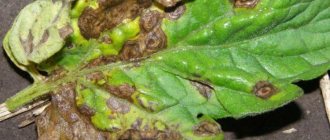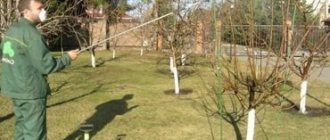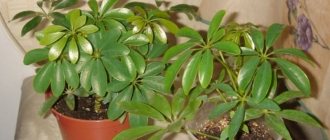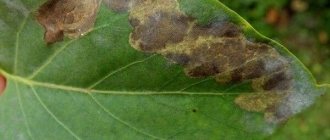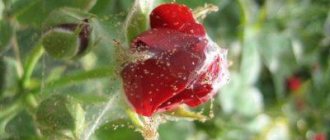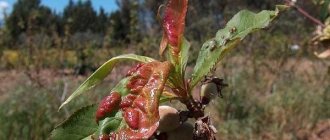White coating on begonia leaves: reasons for its appearance
When a bush is infected with the fungus Oidium begoniae, a white powdery coating forms on the above-ground part of the begonia. First, spots appear, gradually the tissue turns glassy and the leaf dies.
Powdery mildew appears due to leaves being wet for a long time and high air temperatures. Also, the disease can be provoked by the application of nitrogen fertilizers in large quantities with a simultaneous lack of calcium in the soil. Powdery mildew actively develops on begonia bushes with low turgor, since such a plant does not resist fungus well. If growing conditions are favorable for begonia, pockets of powdery mildew are localized and do not cause serious harm to the bush. Most often, the disease manifests itself when the temperature drops to 18-20°C and the humidity rises to 60-80%.
What to do?
If a once chic and beautiful begonia suddenly dried out, do not be upset or panic. Perhaps the plant can be saved. This is possible if the above-ground part has dried out and the root system of the flower is alive. To revive a begonia, you should perform a number of simple steps.
- Carefully remove the root system from the soil, being careful not to damage its individual sections.
- Inspect the roots. If there are no parasites or rot on them, the plant can be helped. In this case, the damaged areas of the roots are removed, and the remaining ones are planted in a pot with soil.
- The soil should be fed, and then cover the pot with a plastic bag.
- Begonia is placed in a bright and warm place. If everything is done correctly, new stems and young foliage will soon appear from the soil.
Drying leaves is not always a consequence of improper care, pest attack or infection. Don't worry if the lower foliage dies off gradually. This is a natural process characteristic of most plants. If serious problems are detected, the begonia should be provided with high-quality care and treatment, and then the plant will again delight with dense foliage and abundant flowering.
To learn why begonia leaves dry, watch the following video.
How to cure begonia from white plaque?
It is clear that it is necessary to create favorable conditions for begonia: ventilate, regularly water, provide sufficient light and temperature. Dried and diseased leaves are carefully removed from an infected begonia. If there are few foci, diseased shoots are cut off.
How to treat begonia? You can apply this treatment, maintaining a gap of a week: first, spray with a solution of potassium permanganate (2-3 g of granules, 10 liters of water), then the leaves are washed with a soapy solution of soda ash (10 liters of water, a little less than half a bar of soap, 50 g of soda). A week later, the begonia is sprayed with garlic infusion, for which 15 g of crushed cloves are taken per liter of water (the product needs to infuse for a day).
You can spray the affected begonia with a mixture of antibiotics (diluted 1:1) - penicillin tablets 100 units/ml, terramycin (same dosage). As for fungicides, Skor, Topaz, Benomyl, Anvil, Baykor, Rubigan, Vectra and other preparations of similar action are used to treat begonias against powdery mildew.
Experienced gardeners use fermented slurry to suppress the growth of powdery mildew fungus. To prepare the solution, dissolve 1 part manure in 3 parts water and leave the liquid for 3 days. Before use, you need to dilute the product in a ratio of 1:3.
Begonia diseases can quickly turn a gorgeous flower into an unsightly, tortured specimen. Therefore, for flower growers who purchase an ornamental plant called begonia, diseases and the fight against them become one of the main problems.
Conditions of detention
A change in the usual climate, for example, if the plant is taken out onto the balcony, can cause the leaves to dry out quickly. If this happens, the flower must be returned to its original place, the dried leaves must be torn off, and a complex of fertilizers must be added.
Plants feel best on window sills in the southwestern and southeastern parts of the house.
This problem can be solved if you move the plant away from heating devices, since they lead to dry air around. If this is not possible, you need to place a vessel with water next to the flower and spray the begonia daily.
The same problem can be seen in bushes that grow outside. The reason is the same - dry air.
One of the types of flowering garden begonia
To eliminate it, frequent watering and spraying the plant in the morning and evening is necessary.
It must be remembered that stagnation of water on the roots can lead to the falling of the lower leaves. Therefore, watering should be moderate but sufficient.
You should also not spray a flower with “fluffy” leaves. To humidify the air, you just need to spray water from a spray bottle around the begonia.
Proper watering. The best watering is considered to be watering that occurs at the same time, while evenly moistening the soil.
In summer, watering is carried out frequently to prevent the soil from drying out. As the weather gets colder, watering becomes moderate, preferably with warm water.
Begonias react very sensitively to low-quality tap water with a high content of fluorine and chlorine. To water the flower, it is better to use filtered, settled or melt water.
The optimal air temperature for begonia is 18 degrees. In summer, she can tolerate a maximum of 24 degrees. The plant does not tolerate drafts. It reacts to increases and decreases in temperature by drying out the leaves.
If the plant was purchased in a store, you do not need to immediately replant it in new soil and pot, as it will take some time to acclimatize. Indoor begonias need to be replanted once a year, making sure that the plant does not come into contact with the ground.
Variegated Begonia
It is better to plant begonia in clay pots that have high breathability.
As a rule, loamy soil with the necessary selection of minerals and microelements is used as soil for it.
A soil consisting of sand and peat with an admixture of leaf soil in a 1:2 ratio is ideal. The soil should have a low level of acidity, and also be loose and light.
When improper care is to blame
Begonia cannot be called unpretentious. The plant needs good care. Otherwise, illnesses begin to overcome him.
Leaves curl and dry
In this state, the plant signals a severe lack of moisture in the soil and air. To save it, it is necessary to urgently water it and remove it from the bright sun, and to prevent such situations in the future. Begonia is light-loving, but direct sunlight is not an easy test for it.
New leaves grow small
This is how begonia reacts to a decrease in soil nutrition. The plant needs to be fed. Liquid fertilizer for domestic flowering plants is optimal for quick help. And in the future you should not neglect feeding, do it every 2 weeks. Leafy begonias need fertilizers rich in nitrogen, while flowering begonias need fertilizers rich in phosphorus.
Important! The best soil for planting begonias is considered to be a mixture of leaf soil (1 tsp), humus, peat and sand (0.5 tsp each).
Stems and tops are affected by rot
This is a continuation of root rot, which appears when there is excess moisture. To eliminate it, it is necessary to stop watering for a while, place the begonia in the sun, and in the future avoid waterlogging.
Important! The flower does not like changes in location, so this is done only in vital cases.
In winter the leaves fall
Discoloration and winter fall of leaves eloquently indicate too cool a temperature or the presence of drafts, which begonia really does not like. Eliminating these reasons will return everything to its place.
Care: soil, watering, temperature conditions
When begonia leaves dry, it is necessary to determine the cause, choose methods, means and methods of elimination.
- Selection of capacity. Pots should be chosen low but spacious; there should be enough space for the root system. Preference is given to ceramic containers: they allow air to pass through. Before use, they are soaked in water for several hours. If the container has already been used, be sure to thoroughly rinse, disinfect and dry it.
- Temperature changes. Reacts sharply to sudden changes in temperature and does not like drafts. This can happen when you turn on the air conditioner, heater, or move the pot from a warm room to a loggia or balcony. When the first signs of wilting appear, it is worth returning it to its previous “place of residence” and monitoring the room temperature. From October to January, when they are at rest, they are moved to a cooler place, but the air temperature should not be lower than 12 degrees.
- Watering. It is recommended to use settled or filtered warm water; under no circumstances should you water with cold tap water. Add a small amount of lemon juice or citric acid to it. Watering is carried out twice a week in hot weather and once in winter. It is advisable to carry out the procedure at the same time. Ensure good drainage so that water does not stagnate. Over-wetting the soil is unacceptable.
- Priming. The soil mixture is purchased in specialized stores or prepared independently from peat, compost, sand, and leaf soil. The main requirement is that the soil should not have a high level of acidity.
The problem may be dry indoor air. In such cases, place containers with water and carry out regular spraying. Or they place the pots on trays with sand and pebbles, which are periodically moistened.
Begonia: leaf diseases, photos, how to treat.
The main wealth of the group of leaf begonias is the pubescent leaves that appear immediately from the root. They can be not only green, but also red, yellow, white, silver and even brown, and have a variety of shapes, borders and multi-colored spots. Diseases can irreparably disrupt this splendor.
Spots and yellow rings on leaves
Such manifestations of begonia disease and subsequent deformation of the leaf blades indicate a cucumber mosaic virus, against which there are no methods of combating. All that remains is to eliminate the diseased plant as quickly as possible in order to stop the further spread of the infection.
Gray mold
It is also called gray rot. First, the leaves become covered with wet white spots with a gray coating. Subsequently, the leaf blades turn black and dry out. The cause of this begonia disease is the Botrytis fungus, the appearance and reproduction of which is promoted by dampness, which should be removed urgently. Affected areas of the plant will have to be removed. If the disease is just beginning, you can try to limit yourself to treatment with Bordeaux mixture (1 percent solution) or an aqueous mixture (1 l), laundry soap (20 g) and copper sulfate (2 g). If the result is negative, Fundazol and stronger antifungal fungicides are used - Topsin, Euparen, Polycarbacin, BMK, Rovral.
Powdery mildew
The onset of this fungal disease of begonias can be recognized by round plaques of white, flour-like plaque, which then spreads to all the leaves, which turn brown and dry out. The reason is excessive saturation of air and soil with moisture, high temperature.
Control measures include processing:
- Foundationazole (0.1% solution);
- a liquid of copper sulfate (2 g), tar soap (20 g) and water (1 l);
- ground or colloidal sulfur;
The photo shows root rot in begonia
- you can use Fitosporin, Alirin-B, Planriz;
- In particularly difficult cases, use Strobin and Topaz.
Black root rot
When plants stop growing and wilt, be sure to look at the condition of the roots. If they turn black and begin to rot, there are symptoms of black root rot - a disease that appears under conditions of excessive watering. Removing diseased roots and spraying with Benomyl will help to cope with it.
Read also: Feijoa jam with persimmon recipe
Diseases
Not many diseases affect begonia, but it is important to carry out timely treatment to prevent the death of the flower. We present to your attention the diseases of this plant, their signs and methods of rehabilitation.
Powdery mildew
First of all, let's consider what to do if powdery mildew appears on begonia. This disease is more common than others and affects all components of the plant that are located above the soil surface. The first sign of appearance is round spots with a white coating on the leaves. Over time, they grow, covering the entire plate. If no action is taken, the foliage will turn brown and fall off.
Treatment consists of the following medications:
- solution of morestan (0.05%) or foundationol (0.05-0.1%);
- colloidal sulfur solution (0.3-0.5%) – spraying is carried out during the growing season;
- 2 grams of copper sulfate and 20 g of tar soap are dissolved in a liter of water - a fairly effective remedy that can be prepared from scrap materials available to any gardener.
Gray rot
When studying tuberous begonia diseases and their treatment, one should not exclude the possibility of the formation of gray rot, whose appearance is associated with a microscopic fungus called botratis. Its development is promoted by a large amount of moisture and warm air in the room. As a result, spores form and move to other plants in the room when watered or due to the wind.
Signs include the appearance of watery, gray spots on leaves and buds. Usually the damage starts from the top of the plant. Subsequently, the spots become similar to wet rot, the flower stalks become covered with mucus, and the stems rot and die. The foliage turns black and falls off completely.
Treatment consists of spraying the begonia with a soap solution (in the ratio indicated in the list above) or Bordeaux mixture (1%).
Note! If the plant is grown in a greenhouse, then sufficient ventilation should be provided and watering should be reduced to the required minimum.
If the flower is severely damaged, spray with a special solution, which consists of the following components:
- Topsin – 0.05-0.2%.
- Polycarbacin - 0.4%.
- BMK - 0.05-0.1%.
- Fundazol in the same concentration.
- Euparen – 0.2%.
Bacterial spot
The first stage of the disease appears as small watery spots on the back of the plate. When brown spots are noticed on the leaves of a begonia, we can talk about the second stage and a severe disease of the plant. At the same time, blackening of the buds and petioles occurs. There is no effective treatment, so the flower is destroyed. The soil must be disinfected before reuse, but it is better not to risk it and throw it away.
As a preventive measure, treatment is carried out with a suspension of copper oxychloride (0.5%). The procedure is repeated after 2 weeks.
Banal dry air should not be ruled out. In this case, brown spots form only at the tips of the leaf blade. A solution might be to place a container of water nearby or install an automatic humidifier.
Ring spot
This disease is caused by a tomato virus. Appears as yellow-green concentric lines or spots. The plant may acquire a bronze color, and some areas become necrotic. Often the carrier is one of the types of sap-sucking pests. Insects should be removed immediately to prevent infection of other flowers.
There are no effective methods for rehabilitating begonia, so the plant will have to be thrown away. Even when treated with fungicides, the virus will remain in the root system and make itself felt next spring.
Black root rot
Due to this begonia disease, the leaves wither at the edges for no apparent reason. You can detect signs when replanting the plant - black spots of rot will be visible on the roots. The damaged areas are removed, after which they are treated with Benomyl.
Prevention lies in proper watering - the soil should not be flooded, moisture is replenished only after the top layer of soil dries out.
Vascular bacteriosis
Signs: the edges of the leaf turn yellow, then become darker, acquire a brown color, and oily spots appear. The vessels through which the juice moves turn black. Treatment consists of removing the affected leaves and treating with fungicides.
Blooming begonia: diseases and their control
The group of flowering begonias is even more demanding on growing conditions, because the formation of buds, flowering, and seed formation lead to an increased consumption of vital energy. The slightest failure can cause illness.
Leaves are limp and dry
This is a consequence of a lack of water at the roots and in the air. A flowering plant needs full watering. The art of the gardener is not to overwater the begonia, but also not to starve it.
Important! For begonias, which originate from the tropics, high air humidity is vital. However, the result of spraying is brown spots. It is best to turn on a humidifier or place flower pots on a tray with expanded clay or moss moistened with water.
Yellowed leaves
Drooping, yellowed leaves clearly indicate that the plant is watered too often, but does not provide the necessary warmth. As a result, problems with flowering appear. All these shortcomings require immediate elimination.
Rot has settled at the base of the stems
This is also an indicator of excessive water use. Control measures: the soil must be dried urgently and the correct conclusions must be made regarding watering. Otherwise, the plant will die.
Leaves, flowers, buds rot
When the bases of the stems are not damaged, but the leaves of the begonia, its flowers, and buds are affected by rot, this
Flowering begonias are affected by pernosporosis (downy mildew)
the result of frequent spraying of a plant for which such a procedure is absolutely contraindicated. Begonia is defenseless against excess moisture.
Downy mildew
Along with ordinary powdery mildew, flowering begonias are affected by pernosporosis - downy mildew. The spores of these fungi are contained in the soil and are activated when soil and air humidity increases. The disease appears as white spots that are soft to the touch, spreads instantly and leads to the death of leaves. Control measures are similar to treatment for powdery mildew.
Begonia - home care
What to do if begonia leaves curl? If only the lower leaves of the plant dry and curl, then this may be a natural process of old leaves dying, but if the leaves darken and dry out throughout the begonia, you should start to worry.
Watering should be moderate: do not overdo it with moisture, but do not allow the soil in the begonia pot to dry out. Curling of begonia leaves may be a sign of insufficient soil nutrition, which means it's time to feed the plant.
How often to spray begonia? Begonia loves moist air, but reacts sharply to excessive moisture in the soil in the pot. Begonia varieties with smooth leaves can be subjected to water procedures, but varieties with “fluffy” leaves are better not to be sprayed, but to spray water around the flower, humidifying the air.
Where to place a pot of begonia? Begonias feel great on window sills facing southwest and southeast.
What to do if dark spots and holes appear on a begonia leaf? Very often, if watered incorrectly, begonia leaves become stained with cold or hard water. And the holes can be a trace of a burn formed by a drop of water and a sun ray.
Why do double begonias have non-double flowers? This mysterious phenomenon is quite understandable: on double begonias, female (pistillate) flowers of simple shape and male (staminate) flowers develop. Male flowers are double in shape. Male and female buds open at different times. If desired, female non-double flowers can be removed; this will preserve the plant’s strength and it will bloom profusely with double flowers.
When should the first flowers appear on begonias? Not until the main stem has 5-6 knees. In rare cases, begonia blooms earlier at home.
What to do if the begonia flowers darken and fall off? The cause may be water getting on the begonia buds.
What to do if powdery spots appear on the leaves? It could be powdery mildew or gray mold. Remove diseased leaves and treat the plant with a fungicide. Ventilate the room more often.
Why do begonia leaves and flowers fall off? There are several possible reasons: water got on the plant, the air in the room is too dry, or insufficient watering is to blame.
Begonia pests. Most often, at home, damage to begonias is caused by insects such as aphids and spider mites.
When should begonia be replanted? Spring is the best time to transplant begonias.
What soil is optimal for begonias? The ideal mixture for begonia: turf, leaf, coniferous soil, peat and regular river sand.
Why do begonia buds fall off? There are many reasons: waterlogging or vice versa - insufficient watering, drafts and even changing the position of the flowerpot relative to the light source by several degrees, not to mention moving the flower from one room to another.
Why doesn't begonia bloom? Perhaps your begonia does not have enough light, the room has low humidity, it is too hot or too cold, or perhaps you have placed it in a draft or overfed it with fertilizers.
Read about the correct propagation of begonias.
If, despite all your efforts, the begonia continues to droop, root a branch just in case, perhaps your begonia will say goodbye to you.
Main pests of begonias
Despite their small size, begonia pests are aggressive, insatiable and can lead to the death of the plant. Fighting them is not an easy task and requires patience and perseverance.
Greenhouse whitefly
A tiny (1.5 mm) butterfly, having settled on the leaves of a begonia, multiplies incredibly quickly and actively sucks the juices from the plant. In an apartment, a harmful insect is eliminated with a solution of 10 liters of water and 40 g of soap. Leaves on which larvae have settled on the reverse side will have to be destroyed. In greenhouses and open ground, potent intexicides are used: Apploud, Aktaru, Teppeki, Mospilan - three times, at weekly intervals.
Nematodes – leaf and root-knot
Leaf nematodes target the stems, leaves and buds of begonias, gall nematodes settle on the roots and lower part of the stem, but the final result of the activity of microscopic worms is the same - the death of the plant. Pests detect their presence by light green spots that turn brown over time and specific swellings.
Preventing the appearance of nematodes is much easier than getting rid of them later. Therefore, the planting soil must be steamed. If a pest is detected, the affected areas are removed, and the plant is watered with Heterophos at a concentration of 0.05-0.2 percent.
Soft false scale
Another parasitic insect is the soft scale insect. These begonia pests actually hide inside the plant, which stops growing and eventually dries out. The only method of control is painstaking manual cleaning with a soft brush moistened with garlic infusion of the areas of the plant that have been infested by pests. The operation is repeated continuously after 2-3 weeks.
Spider mites on begonia leaves photo
Red spider mite
If a thin web begins to entangle the begonia, it means that the plant has been chosen by spider mites - lovers of warmth and abundant humidity. Over time, the color of the leaves will become marbled, and then they will turn yellow and fall off. Pests will retreat after spraying the diseased plant with Decis.
Greenhouse aphid
Pests reproduce like an avalanche: 1 female produces up to 100 new insects every 7 days. And they are all busy sucking the juice from the withering plant. At home, you can get rid of aphids by spraying with tobacco infusion (100 g of shag is infused for 2 days in a liter of water, diluted 2 more times before use) and a solution of soap.
Greenhouse thrips
Due to their rather large size, pests are clearly visible. The harm they cause is also visible to the naked eye: the leaves lose color, the plant stops growing, and loses its beauty. Thrips love humidity and high temperatures, so they most often attack begonia in the summer.
Control measures include the use of:
What is good about begonia elatior and myths about this plant
One of the advantages of this begonia is, of course, its magnificent, abundant and long flowering. The plant produces many flower stalks, each with dozens of flowers.
When the first ones fade, the next ones immediately open. Thus, continuous lush flowering can last for months.
Also, begonia elatior does not have a tuber, which greatly simplifies its care.
Let's also look at all the peribegonia misconceptions that I have heard about these wonderful flowers.
Myth 1. These begonias bloom magnificently only in stores.
It is not true. At home, with proper care, begonia blooms beautifully due to its natural qualities.
Tested on a dozen varieties from our own collection. You just need to know the secrets on how to help the plant bloom magnificently (see below).
Myth 2. Elatior is a winter begonia and they bloom only in winter; they need a short day to bloom.
There's really nothing like it. Elatioras bloom beautifully in spring and much more abundantly than in winter.
They really love good bright lighting, and long daylight hours do not interfere with their flowering.
I have no idea why they call winter begonia, perhaps because winter is also not a hindrance to its flowering.
This plant can bloom at any time of the year.
Myth 3. Elatiors are disposable plants that disappear after flowering (you need to throw them away after flowering).
Not true. These begonias do not disappear after flowering and they are not disposable at all.
They just can stretch out, grow and lose their original compact appearance. Because of this, they look a little disheveled.
But nothing critical happens to them for which they need to be immediately thrown into a bucket.
What to do with faded begonia elatior? Nothing special: remove empty flower stalks.
You can do pruning if the plant has grown too much and the shoots have become elongated. Cut shoots can be rooted.
Then the plant will grow and bloom again.
Myth 4: Elatiors rot easily without any reason.
Oh no. They don't just rot. There are reasons for this, of course, and especially improper care.
Below we will look at what conditions this plant needs in order for it to grow and delight its owner.
Powdery mildew
Powdery mildew is a fungal disease, and if left unchecked, it can develop into an epidemic.
Powdery mildew on begonia
Symptoms of powdery mildew
The main sign of powdery mildew is the appearance of a gray or white coating on the leaves and stems, which is easily erased. This plaque is a collection of thousands of parasitic fungi. They quickly spread throughout the plant and upon contact are transferred from one plant to another. The spores of these fungi penetrate the plant tissue and take nutrients from it. This leads first to growth cessation and then to the death of the plant.
Over time, powdery plaque forms small bags of spores. At first they are yellow in color, and then they darken and turn brown. In the fall, the spores “fall asleep” and in the spring they begin to spread again.
Most often, powdery mildew affects garden and garden plants, such as cucumbers, pumpkin, currants, gooseberries, raspberries, apple trees, etc. Among indoor plants, begonias, violets and hibiscus suffer from powdery mildew.
The main sign of powdery mildew is a white or gray coating on the leaves.
Prevention of powdery mildew
The occurrence and spread of powdery mildew is caused by unfavorable conditions such as too high air humidity, dry soil and improper care. Plant leaves should always be kept clean: wipe the dust on them with a damp cloth or spray them with a spray bottle. Fertilizing with nitrogen fertilizers increases the likelihood of powdery mildew, and the use of phosphate and potassium fertilizers, on the contrary, reduces it.
Powdery mildew affects not only leaves, but also buds and flowers
Treatment of powdery mildew
If a plant shows signs of such a disease, it must be isolated from other plants. Next, depending on the degree of damage, choose one of the options: remove all damaged leaves or simply wipe off the plaque with a cloth. If the plant is severely affected, it must be destroyed.
After this, it must be treated with a suitable fungicide (from the Latin fungus - mushroom and caedo - I kill) - a drug that destroys fungal diseases. On sale you can find the following fungicides that help in the fight against powdery mildew: Bayleton, Quadris, Zlato, Topaz, Fundazol, Fundazim, Vitaros, etc.
Traditional methods of treating powdery mildew
Ash tincture: pour 1 tablespoon of ash into 1 liter of boiling water and leave for 2 days. Then strain and add 5 ml of liquid soap (or dilute regular soap in water). Carry out the treatment 2-3 times with an interval of 7 days.
Garlic tincture: finely chop 5-6 cloves of garlic and pour 1 liter of boiling water. Let it brew for 4-5 hours, then filter and treat the plant. Repeat treatment after 7 days.
Read also: Super premium dry dog food
Potassium permanganate solution: dilute 2.5 g of potassium permanganate in 10 liters of water. Treat the plants several times at intervals of one week.
Reproduction of begonia elatior
Oh, this is a sore subject! I have a whole article with my experiments.
I also recommend reading this long work





